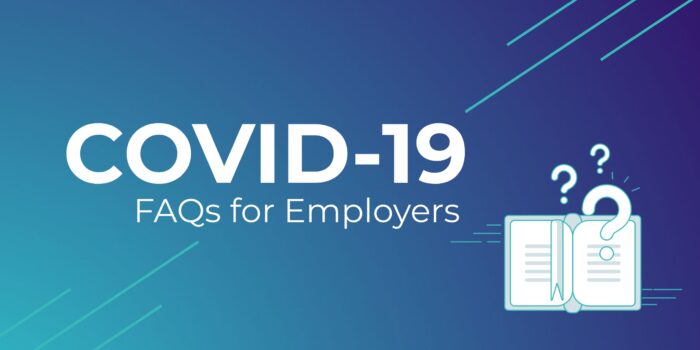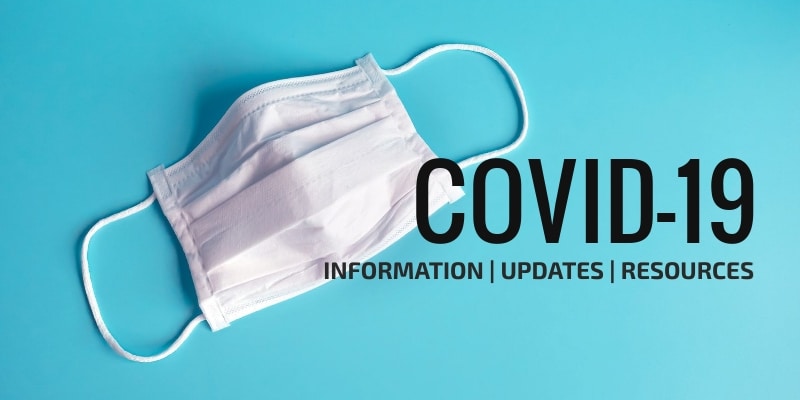 The COVID-19 pandemic continues to bring forth a variety of questions for businesses. Employers can take a number of preventive steps to help keep employees safe, but they should also prepare to respond to various situations that can occur in the workplace.
The COVID-19 pandemic continues to bring forth a variety of questions for businesses. Employers can take a number of preventive steps to help keep employees safe, but they should also prepare to respond to various situations that can occur in the workplace.
This article provides COVID-19 general business FAQs from the Centers for Disease Control and Prevention (CDC). These FAQs build on the CDC’s interim guidance for businesses and employers and its guidance for critical infrastructure workers. The CDC’s guidance is intended to supplement—not replace—federal, state and local mandates regarding the COVID-19 pandemic.
 What should I do if an employee comes to work with COVID-19 symptoms?
What should I do if an employee comes to work with COVID-19 symptoms?
Employees who have COVID-19 symptoms when they arrive at work or become sick during the day should immediately be separated from other employees, customers and visitors, and be sent home. Employees who develop symptoms outside of work should notify their supervisors and stay home.
Sick employees should follow CDC-recommended steps to help prevent the spread of COVID-19. Employees should not return to work until they have met the criteria to discontinue home isolation and have consulted with a health care provider. Employers should not require sick employees to provide a COVID-19 test result or health care provider’s note to validate their illness, qualify for sick leave or return to work. Health care provider offices and medical facilities may be extremely busy and not able to provide such documentation in a timely manner.
What should I do if an employee is suspected or confirmed to have COVID-19?
In most cases, an employer does not need to shut down their facility, but should close off any areas used for prolonged periods of time by the sick person, and:
- Wait 24 hours before cleaning and disinfecting to minimize potential for other employees being exposed to respiratory droplets. If waiting 24 hours is not feasible, wait as long as possible.
- Follow the CDC cleaning and disinfection recommendations:
- Clean dirty surfaces with soap and water before disinfecting them.
- To disinfect surfaces, use products that meet Environmental Protection Agency (EPA) criteria for use against SARS-CoV-2, the virus that causes COVID-19, and are appropriate for the surface.
- Be sure to follow the instructions on the product labels to ensure safe and effective use of the product.
- Individuals may need to wear additional personal protective equipment (PPE) depending on the setting and disinfectant product they are using.
If an employee is confirmed to have COVID-19, employers should inform fellow employees of their possible exposure to COVID-19 in the workplace, but maintain confidentiality as required by the Americans with Disabilities Act (ADA).
Employees who test positive for COVID-19 (using a viral test, not an antibody test) should be excluded from work and remain in home isolation if they do not need to be hospitalized. Employers should provide education to employees on what to do if they are sick.
Employers may need to work with local health department officials to determine which employees may have had close contact with the employee with COVID-19 and who may need to take additional precautions, including exclusion from work and remaining at home.
Most workplaces should follow public health recommendations for community-related exposure and instruct potentially exposed employees to stay home for 14 days, telework if possible and self-monitor for symptoms.
Critical infrastructure workplaces should follow CDC guidance for dealing with critical infrastructure employees who may have had exposure to a person with a suspected or confirmed COVID-19 infection.
Sick employees should follow CDC-recommended steps. Employees should not return to work until they have met the criteria to discontinue home isolation and have consulted with a health care provider. Antibody test results should not be used to make decisions about returning employees to the workplace.
Employers should not require a sick employee to provide a negative COVID-19 test result or health care provider’s note to return to work.
What should I do if I find out several days later, after an employee worked, that they were diagnosed with COVID-19?
If it has been less than seven days since the sick employee used the facility, clean and disinfect all areas used by the sick employee following the CDC cleaning and disinfection recommendations. If it has been seven days or more since the sick employee used the facility, additional cleaning and disinfection is not necessary. Continue routinely cleaning and disinfecting all high-touch surfaces in the facility.
Other employees may have been exposed to COVID-19 if they were in “close contact” (within approximately 6 feet) of the sick employee for a prolonged period of time.
If an employee is confirmed to have COVID-19, employers should inform fellow employees of their possible exposure to COVID-19 in the workplace, but maintain confidentiality as required by the ADA.
Those who have symptoms should self-isolate and follow CDC-recommended steps. In most workplaces, those potentially exposed—but with no symptoms—should remain at home or in a comparable setting and practice social distancing for 14 days.
Critical infrastructure employees should follow this guidance if they potentially had exposure to a person with a suspected or confirmed COVID-19 infection. A critical infrastructure employee who is symptom-free and returns to work should wear a cloth face covering at all times while in the workplace for 14 days after their last exposure.
Employees not considered exposed should self-monitor for symptoms. If they develop symptoms, they should notify their supervisor and stay home.
If an employee has been exposed but is not showing symptoms, should they be allowed to work?
Employees may have been exposed if they were in “close contact” with someone who is infected, which is defined as being within about 6 feet from a person with COVID-19 for a prolonged period of time.
Potentially exposed employees who have symptoms of COVID-19 should self-isolate and follow CDC-recommended steps.
Potentially exposed employees who do not have symptoms should remain at home or in a comparable setting and practice social distancing for 14 days.
All other employees should self-monitor for symptoms and wear cloth face coverings when in public. If they develop symptoms, they should notify their supervisors and stay home.
How can I protect employees who may be at higher risk for severe illness?
Have conversations with employees if they express concerns about COVID-19 infection. Some people may be at higher risk of severe illness. This includes older adults (65 years and older) and people of any age with serious underlying medical conditions. By using strategies that help prevent the spread of COVID-19 in the workplace, employers can help protect all employees, including those at higher risk. These strategies include:
- Implementing telework and other social distancing practices
- Actively encouraging employees to stay home when sick
- Providing sick leave
- Promoting hand-washing
- Providing supplies and appropriate PPE for cleaning and disinfecting workspaces
- Requiring all employees to wear cloth face coverings
In workplaces where it is not possible to eliminate face-to-face contact (such as retail), consider assigning employees who are at higher risk of severe illness tasks that allow them to maintain a 6-foot distance from others, if feasible.
Employers should not require employees to provide a note from their health care provider when they are sick. Instead, allow them to inform their supervisors or employee health services when they have conditions that put them at higher risk for diseases.
When is a cloth face covering not appropriate while at work, and what can employees wear instead?
Cloth face coverings can prevent the wearer from spreading COVID-19 to others, but they may not always be appropriate. Employees should consider using an alternative under certain conditions at work, including:
- If they have trouble breathing
- If they are unable to remove it without help
- If it interferes with vision, glasses or eye protection
- If straps, strings or other parts of the covering could get caught in equipment
- If other work hazards associated with wearing the covering are identified and cannot be addressed without removal of the face covering
Cloth face coverings should not be worn if their use creates a new risk (e.g., interferes with driving or vision, or contributes to heat-related illness) that exceeds their benefit of slowing the spread of COVID-19.
The Occupational Safety and Health Administration (OSHA) suggests that an employee wear a face shield if a cloth face covering is recommended but the employee cannot tolerate wearing a cloth face covering. If used, a face shield should cover the entire front and sides of the face and extend below the chin.
Are cloth face coverings the same as PPE?
No, cloth face coverings are not PPE. These face coverings are not respirators and are not appropriate substitutes for them in workplaces where respirators are recommended or required for respiratory protection.
How often should employees wash their hands while at work?
The CDC recommends employees protect themselves from respiratory illness with everyday preventive actions, including good hand hygiene. Employees should wash hands often with soap and water for at least 20 seconds, or use a hand sanitizer that contains at least 60% alcohol if soap and water are not readily available, especially during key times when persons are likely to be infected by or spread germs, including:
- After blowing one’s nose, coughing or sneezing
- Before, during and after preparing food
- After using the toilet
- After touching garbage
- Before and after the work shift
- Before and after work breaks
- After touching objects that have been handled by customers or other employees
What is social distancing and how can my workplace do that?
Social distancing means avoiding large gatherings and maintaining distance (at least 6 feet) from others when possible. Strategies that businesses could use include:
- Allowing flexible worksites (such as telework)
- Allowing flexible work hours (such as staggered shifts)
- Increasing physical space between employees at the worksite.
- Increasing physical space between employees and customers (such as a drive-thru and partitions
- Implementing flexible meeting and travel options (such as postponing nonessential meetings or events)
- Delivering services remotely (e.g., phone, video or web)
- Delivering products through curbside pickup or delivery
Should employers screen employees for COVID-19 symptoms, such as with temperature checks?
Screening employees is an optional strategy that employers may use. Performing screening or health checks will not be completely effective because asymptomatic individuals or individuals with mild, nonspecific symptoms may not realize they are infected and may pass through screening. Screening and health checks are not a replacement for other protective measures, such as social distancing.
Consider encouraging individuals planning to enter the workplace to self-screen prior to coming on-site and not to attempt to enter the workplace if any of the following are present:
- Symptoms of COVID-19
- Fever equal to or higher than 100.4 F
- Are under evaluation for COVID-19 (for example, waiting for the results of a viral test to confirm infection)
- Have been diagnosed with COVID-19 and not yet cleared to discontinue isolation
The ADA permits employers to make disability-related inquiries and conduct medical exams if job-related and consistent with business necessity.
Generally, measuring an employee’s body temperature is a medical examination. Because the CDC and state and local health authorities have acknowledged community spreading of COVID-19 and issued precautions, employers may measure employees’ body temperatures.
Inquiries and reliable medical exams meet this standard if they are necessary to exclude employees with a medical condition that would pose a direct threat to health or safety. Direct threat is to be determined based on the best available objective medical evidence. The guidance from the CDC or other public health authorities is such evidence. Therefore, employers will be acting consistently with the ADA as long as any screening implemented is consistent with advice from the CDC and public health authorities for that type of workplace at that time.
The ADA requires that all medical information about a particular employee be stored separately from the employee’s personnel file, thus limiting access to this confidential information. An employer may store all medical information related to COVID-19 in existing medical files. This includes an employee’s statement that they have the disease or suspect they have the disease, or the employer’s notes or other documentation from questioning an employee about symptoms. For example, this may include continuing to take temperatures of everyone entering the workplace and asking questions about symptoms (or requiring self-reporting).
What testing does the CDC recommend for testing employees in a workplace?
The CDC does NOT recommend that employers use antibody tests to determine which employees can work. Antibody tests check a blood sample for past infection with SARS-CoV-2, the virus that causes COVID-19. The CDC does not yet know if people who recover from COVID-19 can get infected again. Viral tests check a respiratory sample (such as swabs of the inside of the nose) for current infection with SARS-CoV-2.
The CDC has published strategies for consideration of incorporating viral testing for SARS-CoV-2 into a workplace COVID-19 preparedness, response and control plan. Different states and jurisdictions may have their own guidance and priorities for viral testing in workplaces. Testing in the workplace could be arranged through an organization’s occupational health provider or in consultation with their local or state health department.
What measures should be taken to protect an employee who must travel for work?
Although travel should be minimized as much as possible during the COVID-19 pandemic, many jobs require travel, and it may not be possible to conduct certain job duties using virtual tools. The following measures may be taken to protect employees while traveling:
- Schedule travel to limit the distance travelled and need for overnight lodging.
- If multiday travel is necessary, coordinate with travel preparers to identify hotels that disinfect rooms between stays and regularly disinfect surfaces in common areas.
- Provide employees with forms of transportation that minimize close contact with others, such as fleet vehicles or rental vehicles.
- If public transportation is used, ask employees to follow the CDC guidance on how to protect themselves when using transportation.
- If flying is necessary, select seats on flights that provide the greatest distance between other travelers and choose direct flights, if possible.
- Disinfect surfaces of rental cars or fleet vehicles (e.g., steering wheel, shifter and arm rests) between each use, using products that meet the EPA’s criteria for use against SARS-CoV-2.
- Make sure employees are provided with necessary supplies and understand protective measures they can take while traveling. These measures include:
- Maintaining a distance of at least 6 feet from other people (social distancing) as much as possible during travel
- Wearing cloth face coverings when a distance of 6 feet is difficult to maintain, such as in airports, airplanes and public transportation
- Using disinfecting wipes to clean commonly touched surfaces inside vehicles and airplanes
- Considering ordering food for pickup or delivery rather than eating out at restaurants
- Hand-washing or using hand sanitizer regularly
- Ensuring that employees know that if they get sick they should stay home (not travel) or return home (if traveling), provided it is feasible for them to travel without endangering themselves or others
- Making sure employees know who to contact if they are sick
For more information, see CDC guidance for travel in the United States.
How do I know if my business is considered critical?
The Department of Homeland Security (DHS) has developed a list of essential critical infrastructure employees to help state and local officials as they work to protect their communities, while ensuring continuity of functions critical to public health and safety as well as economic and national security. State and local officials make the final determinations for their jurisdictions about critical infrastructure employees.

I don’t provide sick leave to my employees. What should I do?
Employers that do not currently offer sick leave to some or all of their employees may want to draft nonpunitive “emergency sick leave” policies. Ensure that sick leave policies are flexible and consistent with public health guidance and that employees are aware of and understand these policies.
In addition to cleaning and disinfecting, what can I do to decrease the spread of disease in my workplace?
Employers can also:
- Provide tissues and no-touch disposal receptacles.
- Provide soap and water in the workplace. If soap and water are not readily available, use alcohol-based hand sanitizer that contains at least 60% alcohol. If hands are visibly dirty, soap and water should be chosen over hand sanitizer.
- Place hand sanitizer in multiple locations to encourage good hand-hygiene practices.
- Place posters that encourage staying home when sick, the importance of hand hygiene and coughing and sneezing etiquette at the entrance to the workplace and in other workplace areas where employees are likely to see them.
- Discourage handshaking.
|
Summary
These FAQs provide guidance from the CDC. However, employers should be aware that CDC guidance changes over time, and should visit the CDC’s website for current guidance. Employers should continue to monitor updates from CDC and follow direction from local health officials.
For additional COVID-19 resources, contact us today.
This HR Insights is not intended to be exhaustive nor should any discussion or opinions be construed as professional advice. Design © 2021 Zywave, Inc. All rights reserved.


